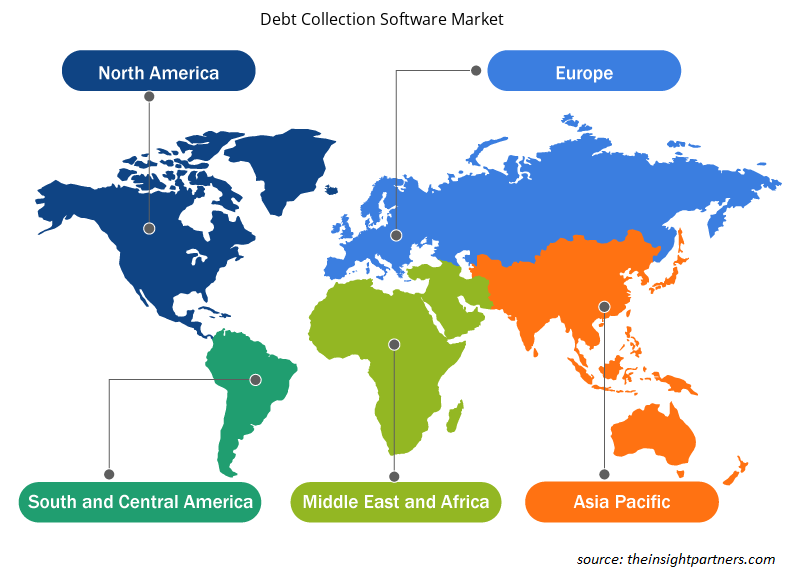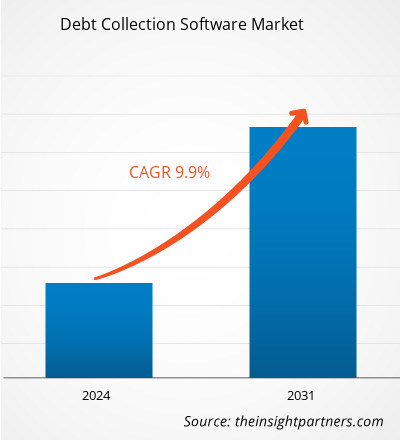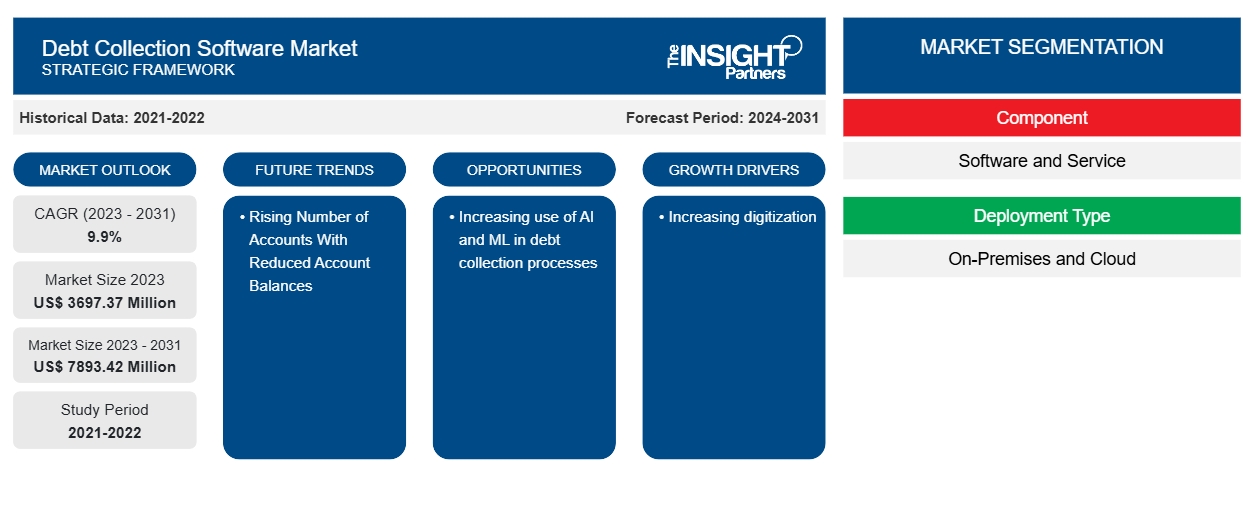债务催收软件市场规模预计将从 2023 年的 36.9737 亿美元增至 2031 年的 78.9342 亿美元。预计 2023-2031 年期间该市场的复合年增长率将达到 9.9%。账户余额减少的账户数量不断增加可能仍是市场的一个主要趋势。
债务催收软件市场分析
债务催收软件具有多种优势。它将所有债务人的资料汇编到一个位置,包括他们的地址、信用卡信息、当前余额以及有关债务拖欠付款的综合报告,例如金额、债务期限等。债权人和 DCA 之间交换有关债务人资料、位置、联系信息、有关其债务的其他信息等信息至关重要。BPO 是此数据共享过程的另一个名称。债务追偿软件和 API 可用于向企业和消费者收取费用。因此,凭借这些优势,债务催收软件市场正在增长。
债务催收软件市场概况
债务催收软件用于自动化债务追偿所涉及的各种流程。此业务流程自动化简化了债务催收流程的许多组成部分,消除了摩擦,从而实现了更有效、更高效的催收工作。在正确的时间连接和参与他们的渠道可以改善客户对业务的看法,并确定成功的可能性。通过添加所有提供有效对话的元素,如数字渠道。自动化、混合参与、API 和 AI 将改变客户互动的方式,并更快地产生更多付款。
定制此报告以满足您的需求
您可以免费定制任何报告,包括本报告的部分内容、国家级分析、Excel 数据包,以及为初创企业和大学提供优惠和折扣
-
获取此报告的关键市场趋势。这个免费样品将包括数据分析,从市场趋势到估计和预测。
债务催收软件市场驱动因素和机遇
数字化程度不断提高
COVID-19 疫情加速了无现金交易的引入。数字银行是常态,由于债务催收涉及金融交易,因此数字化显然对银行和债务催收机构负责。随着拖欠率的增加,世界各地的贷款机构越来越多地利用数字债务催收技术以经济高效的方式提高回收率。因此,日益数字化正在推动债务催收软件市场的发展。
在债务催收过程中越来越多地使用人工智能和机器学习
数字债务催收平台使用人工智能和机器学习,采用各种策略来提高效率。一些平台从多个来源和渠道获取关键数据。这些数据可能包括借款人的个人资料、收入、选择、信用和财务历史以及付款记录等信息,以创建智能微细分,提高贷方采用的传统催收策略的效率。因此,在债务催收过程中增加人工智能和机器学习的使用将增加市场机会。
债务催收软件市场报告细分分析
促成债务催收软件市场分析的关键部分是组件、部署类型、组织规模和行业垂直。
- 根据组成部分,债务催收软件市场分为软件和服务。定制部分在 2023 年占据了更大的市场份额。
- 根据部署类型,市场分为本地和云。表面安装部分在 2023 年占据了更大的市场份额。
- 根据组织规模,市场分为大型企业和中小型企业。SMEs.
- 根据组织规模,市场分为 IT 和电信、BFSI、零售、制造业和其他。BFSI, retail, manufacturing, and others.
债务催收软件市场份额按地区分析
债务催收软件市场报告的地理范围主要分为五个地区:北美、亚太、欧洲、中东和非洲、南美和中美。
亚太地区在债务催收软件市场占据主导地位。该地区债务催收软件市场的增长得益于多种因素,例如政府为提高隧道照明可见度而采取的举措不断增多,以及运输业的成熟。 dominates the debt collection software market. The debt collection software market in this region is growing due to various factors, such as increasing government initiatives to improve the visibility of tunnel lighting and the presence of a well-established transportation industry.
债务催收软件市场区域洞察
Insight Partners 的分析师已详尽解释了预测期内影响债务催收软件市场的区域趋势和因素。本节还讨论了北美、欧洲、亚太地区、中东和非洲以及南美和中美洲的债务催收软件市场细分和地理位置。

- 获取债务催收软件市场的区域特定数据
债务催收软件市场报告范围
| 报告属性 | 细节 |
|---|---|
| 2023 年的市场规模 | 36.9737 亿美元 |
| 2031 年市场规模 | 78.9342亿美元 |
| 全球复合年增长率(2023 - 2031) | 9.9% |
| 史料 | 2021-2022 |
| 预测期 | 2024-2031 |
| 涵盖的领域 |
按组件
|
| 覆盖地区和国家 |
北美
|
| 市场领导者和主要公司简介 |
|
债务催收软件市场参与者密度:了解其对业务动态的影响
债务催收软件市场正在快速增长,这得益于最终用户需求的不断增长,而这些需求又源于消费者偏好的不断变化、技术进步以及对产品优势的认识不断提高等因素。随着需求的增加,企业正在扩大其产品范围,进行创新以满足消费者的需求,并利用新兴趋势,从而进一步推动市场增长。
市场参与者密度是指在特定市场或行业内运营的企业或公司的分布情况。它表明在给定市场空间中,相对于其规模或总市场价值,有多少竞争对手(市场参与者)存在。
在债务催收软件市场运营的主要公司有:
- Chetu 公司
- 费埃哲
- CSS 公司
- 益博睿信息解决方案有限公司
- 埃克斯
- Loxon 解决方案
免责声明:上面列出的公司没有按照任何特定顺序排列。

- 获取债务催收软件市场顶级关键参与者概述
债务催收软件市场新闻和最新发展
债务催收软件市场通过收集一手和二手研究后的定性和定量数据进行评估,其中包括重要的公司出版物、协会数据和数据库。债务催收软件市场的一些发展情况如下:
- 苏黎世大学医院 (USZ) 用 Tilbago AG 的 Robo-Inkasso 取代了之前基于 SAP 的债务催收软件解决方案。据 USZ 称,这有助于减少总体人工工作量,从而降低总成本,同时提供更广泛的服务范围。(来源:苏黎世大学医院 (USZ),新闻稿,2022 年 12 月)
- Tally 是一家以帮助人们勤勉偿还信用卡债务而闻名的金融科技初创公司,该公司宣布推出其白标信用卡债务管理软件。这项 B2B 产品扩大了 Tally 的使命,为消费者提供了更好的债务管理途径。Tally 的第一个合作伙伴是一家拥有超过 5000 万用户的大型上市消费品公司,计划于 2024 年 7 月向其用户推出 Tally 的软件。Tally 从现有投资者那里筹集了额外资金来开发其 B2B 产品,迄今为止,已筹集了超过 2 亿美元来构建和扩展该平台。(来源:Tally,新闻稿,2022 年 4 月)
债务催收软件市场报告覆盖范围和交付成果
“债务催收软件市场规模和预测(2021-2031)”报告对市场进行了详细分析,涵盖以下领域:
- 债务催收软件市场规模及全球、区域和国家层面所有主要细分市场的预测
- 债务催收软件市场趋势以及市场动态,如驱动因素、限制因素和关键机遇
- 详细的 PEST/波特五力分析和 SWOT 分析
- 债务催收软件市场分析涵盖主要市场趋势、全球和区域框架、主要参与者、法规和最新市场发展
- 行业格局和竞争分析,涵盖市场集中度、热图分析、知名参与者以及债务催收软件市场的最新发展
- 详细的公司简介
- 历史分析(2 年)、基准年、预测(7 年)及复合年增长率
- PEST和SWOT分析
- 市场规模、价值/数量 - 全球、区域、国家
- 行业和竞争格局
- Excel 数据集
近期报告
相关报告
客户评价
购买理由
- 明智的决策
- 了解市场动态
- 竞争分析
- 客户洞察
- 市场预测
- 风险规避
- 战略规划
- 投资论证
- 识别新兴市场
- 优化营销策略
- 提升运营效率
- 顺应监管趋势























 获取免费样品 - 债务催收软件市场
获取免费样品 - 债务催收软件市场